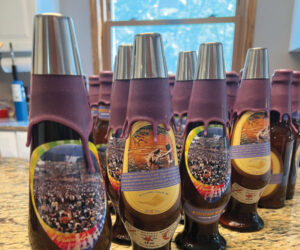Victory Brewing Co.’s Mad King’s Weiss clone
Victory Brewing Co.’s Mad King’s Weiss clone
(5 gallons/19 L, all-grain)
OG = 1.055 FG = 1.008
IBU =30 SRM = 4 ABV = 6.2%
Ingredients
9.8 lbs. (4.5 kg) German Pilsner malt
1 lb. (0.45 kg) European wheat malt
5 oz. (142 g) acidulated malt
6 AAU Spalt Select hops (40 min.) (1.2 oz./34 g at 5% alpha acids)
3.3 AAU Spalt Select hops (30 min.) (0.66 oz./19 g at 5% alpha acids)
Wyeast 3787 (Belgian High Gravity), White Labs WLP570 (Belgian Golden Ale), or Mangrove Jack’s M41 (Belgian Ale) yeast
¾ cup corn sugar (if priming)
Step by Step
Mash in with a relatively thin mash at 144 °F (62 °C). Hold at this temperature for 15 minutes. Raise to 149 °F (65 °C) and hold for 50 minutes, then raise to 158 °F (70 °C) and hold for 30 minutes. Raise to 170 °F (77 °C) for mash out. Recirculate for 10 minutes or until clear and then begin collecting wort.
Sparge the grains when they are first exposed during runoff, preferably using sparge water acidified to 5.2 pH. Collect 6.5 gallons (25 L) of water to account for boil-off and boil for 90 minutes, adding the hops according to the specified schedule in the ingredient list. When boil is complete, whirlpool and let set for about 20 minutes. Chill to 63 °F (17 °C) and transfer to fermenter, pitching twice as much yeast as usual. Oxygenate light to normal if using a liquid yeast strain. Note: Less oxygenation may increase some of the yeast character. As fermentation slows, allow temperature to rise to 65 °F (18 °C) to finish fermenting. Hold the beer at 65 °F (18 °C) until no diacetyl and minimal sulfur is detected, usually 1–2 days. Remove yeast or rack beer off yeast.
Cool the beer down to 32 °F (0 °C) over 3–4 days and hold for a minimum of two days.
Carbonate to 2.6 v/v or add priming sugar to bottle ferment for carbonation.
Victory Brewing Co.’s Mad King’s Weiss clone
(5 gallons/19 L, extract only)
OG = 1.055 FG = 1.008
IBU =30 SRM = 4 ABV = 6.2%
Ingredients
5.1 lbs. (2.3 kg) Pilsen dried malt extract
1 lb. (0.45 kg) wheat dried malt extract
1 tsp. 88% lactic acid
6 AAU Spalt Select hops (40 min.) (1.2 oz./34 g at 5% alpha acids)
3.3 AAU Spalt Select hops (30 min.) (0.66 oz./19 g at 5% alpha acids)
Wyeast 3787 (Belgian High Gravity), White Labs WLP570 (Belgian Golden Ale), or Mangrove Jack’s M41 (Belgian Ale) yeast
¾ cup corn sugar (if priming)
Step by step
Raise 3 gallons (11 L) of clean brewing water to near-boiling temperatures, remove pot from flame and slowly stir in 3 lbs. (1.35 kg) Pilsen dried malt extract (DME). Return to flame and bring to boil. Meanwhile, pre-boil then chill 3 gallons (11 L) of water to use later for topping up the fermenter.
Boil wort for 90 minutes, adding the hops according to the specified schedule in the ingredient list and lactic acid at the start of the boil. A vigorous, rolling boil is ideal, but watch closely to avoid a boilover. Add the remainder of the DME with 5 minutes left in the boil.
Upon completion of the boil, chill to 63 °F (17 °C) and transfer to fermenter, adding pre-boiled and chilled water to top up fermenter to a total volume of 5 gallons (19 L). Pitch twice as much yeast as usual. Aerate light to normal if using a liquid yeast strain. Note: Less oxygenation may increase some of the yeast character. As fermentation slows, allow temperature to rise to 65 °F (18 °C) to finish fermenting. Hold the beer at 65 °F (18 °C) until no diacetyl and minimal sulfur is detected, usually 1–2 days. Remove yeast or rack beer off yeast.
Cool the beer down to 32 °F (0 °C) over 3–4 days and hold for a minimum of two days.
Carbonate to 2.6 v/v or add priming sugar to bottle ferment for carbonation.
Tips for success:
Package within 3 weeks of brewing to accentuate the yeasty mouthfeel.
Experimenting with the oxygenation rates will result in slightly different aroma profiles. For more ester production, try limiting the oxygenation. For a cleaner aroma and finish, oxygenate more vigorously.
Another option is to experiment with a new strain of Belgian yeast that is POF- (phenolic off-flavor negative). The yeast strains listed in this recipe are all POF+. Omega’s OYL-400 (Bananza) is one such strain that is a POF- weiss strain.
Written by Dave Clark

Originally made decades ago for the former Ludwig’s Garden Restaurant in Philadelphia, this beer continues to amaze with its balance of spice and esters. Hoppier and stronger than a typical Bavarian hefeweizen, yet more estery than a Belgian blond ale, the wheat malt plays well with the Belgian Trappist strain making it a favorite of many Victory Brewing fans.


